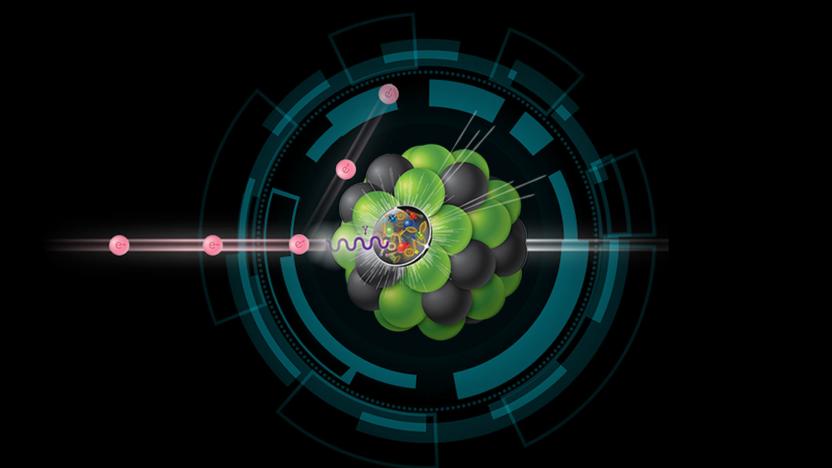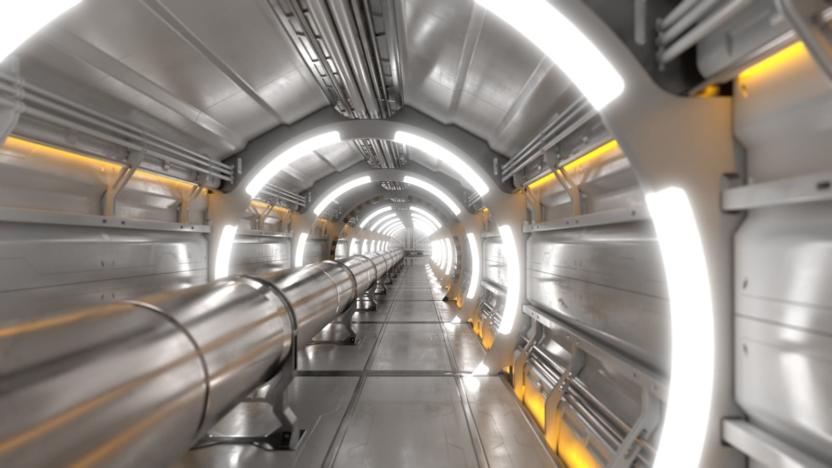Collider
Latest

The next US particle accelerator will be built on Long Island by 2031
The Electron-Ion Collider will try and uncover the secrets of how electrons bind themselves together.

'Twin Peaks VR' trailer offers a dive into David Lynch's mind
If you suspected that Twin Peaks VR would be a head trip, you guessed correctly. Collider and Showtime have released a trailer for the series' official virtual reality experience ahead of its debut later in December, and it feels like a mirror of David Lynch's psyche with the same strangeness as the series. The return to the Red Room is really just one part of your journey -- you'll also return to the train car where Laura Palmer was killed, a log cabin (but whose?) and Sheriff Truman's office, complete with an unsettling Killer BOB orb. It's clear this is tailor-made for the sort of fan who could quote whole scenes verbatim.

CERN plans to build a collider four times bigger than the LHC
Back in 2014, CERN sought the help of over 1,300 contributors to help it conjure up a feasible plan for a new collider much, much bigger than the LHC. Now, the research organization has unveiled preliminary designs for the project named Future Circular Collider (FCC). Based on current plans, it will make the LHC (Large Hadron Collider) look tiny in comparison: the designs are calling for a massive particle accelerator 100 kilometers or 62 miles around. The LHC is only 27 kilometers or 17 miles long. It will also be up to six times more powerful than the smaller accelerator.

ICYMI: Halloween Spooktacular and some tech news too
#fivemin-widget-blogsmith-image-772085{display:none;} .cke_show_borders #fivemin-widget-blogsmith-image-772085, #postcontentcontainer #fivemin-widget-blogsmith-image-772085{width:570px;display:block;} try{document.getElementById("fivemin-widget-blogsmith-image-772085").style.display="none";}catch(e){}Today on In Case You Missed It: Chinese state-run media announced the country will begin building the world's largest super-collider, with an ETA of 2020. Realm Pictures just pulled off another live action shooter game, this time with an alien version and we are all tempted to get Chatroulette accounts. And Tokyo's auto show just wrapped this week and beside the totally Jetsons cars, we were struck by the cool factor of many of the cars' head and tail lights, which are made of lasers.

Scientists find a way to create matter from light
Scientists have long theorized that you can create matter from light by colliding photons, but proving that theory has been a different story -- you need the right high-energy particles to even think of trying. However, it looks like that once-impossible dream is close to becoming reality. Researchers at Imperial College London have discovered a technique that should produce electrons and positrons by colliding two sets of super-energetic photons. To create the first batch of photons, you have to first blast electrons with a laser, and then shoot them at a piece of gold; you produce the other batch by firing a laser at the inside of a small gold can to produce a thermal radiation field. If you collide the two photon sources inside the can, you should see electrons and positrons spilling out.

Primed: The smashing science behind particle accelerators
Primed goes in-depth on the technobabble you hear on Engadget every day -- we dig deep into each topic's history and how it benefits our lives. You can follow the series here. Looking to suggest a piece of technology for us to break down? Drop us a line at primed *at* engadget *dawt* com. Long before the Large Hadron Collider (LHC) could smash its first atoms, researchers manning the Tevatron collider at Fermilab, in a quiet suburb 40 miles west of Chicago, raced to find evidence that the Higgs boson exists. After roughly three decades of service, the Tevatron shut down for good in late 2011, dealing the city of Batavia's largest employer a significant blow. Less than 18 months later, the LHC (the Tevatron's technological successor) also went offline - albeit temporarily. Only four years after recording its first proton collisions, the team at CERN is already scrambling to upgrade the staggering LHC, which lies under parts of no less than five cities in both France and Switzerland. With the world's largest particle colliders smashing a whole lot of nothing together for the next two years at least, the field of high-energy physics research is starting to look resource-starved. Of course, many might ask why exactly we need giant atom smashers like this, or even how they work. It turns out that first part is quite a bit easier to answer than the second. During the last several decades, particle accelerators have revealed the existence of elementary particles such as quarks, led to the discovery of antimatter and generally helped us unlock the mysteries of the universe. And once they were done splitting atoms and probing the darkest corners of theoretical physics, accelerators often led to breakthroughs in medical imaging and cancer research. So, as massive colliders seem ready to land on the endangered species list, it seems as good a time as any to explain what a particle collider is, how it works and what we as a society have to gain from the research.

Pour one out for the Tevatron particle accelerator, because it's shutting down today
The eyes of the physics community are collectively fixed upon Illinois today, where, later this afternoon, researchers at Fermilab will shut down the Tevatron particle accelerator... for good. That's right -- the world's second-largest collider is being laid to rest, after a remarkable 25-year run that was recently halted due to budgetary constraints. Earlier this year, Fermilab's scientists and a group of prominent physicists pleaded with the government to keep the Tevatron running until 2014, but the Energy Department ultimately determined that the lab's $100 million price tag was too steep, effectively driving a nail through the accelerator's subterranean, four-mile-long coffin. First activated in 1985, the Tevatron scored a series of subatomic breakthroughs over the course of its lifespan, including, most notably, the discovery of the so-called top quark in 1995. Its groundbreaking technology, meanwhile, helped pave the way for CERN's Large Hadron Collider, which will now pursue the one jewel missing from the Tevatron's resume -- the Higgs boson. Many experts contend that the collider could've gone on to achieve much more, but its ride will nonetheless come to an inglorious end at 2PM today, when Fermilab director Pier Oddone oversees the Tevatron's last rites. "That will be it," physicist Gregorio Bernardi told the Washington Post. "Then we'll have a big party."

Large Hadron Collider wants to make mini Big Bangs, Sheldon and Leonard disapprove
The Large Hadron Collider has been busily colliding protons since it opened last year, but a new set of experiments starting later this month could tell us more about the beginnings of the universe than we've ever known before. At CERN, where the LHC is housed in Geneva, scientists will attempt to create mini Big Bangs (the full-sized one is generally accepted as having created the actual universe about 13.7 billion years ago). The process will involve shooting lead ions through the 17-mile long collider, and accelerating them to relativistic speeds before colliding them head-on with protons. According to popular wisdom this should cause an explosion resulting in the creation of brand spanking new particles. Although similar experiments have been conducted on a much smaller scale at the Relativistic Heavy Ion Collider, this will be the first time scientists have attempted to accurately recreate conditions exactly like the Big Bang. Hit the source link for the full story.

LHC breaks its own energy record, still less powerful than Lady Gaga
The Large Hadron Collider is no stranger to setting energy records: back at the end of November it broke the 0.98 TeV record by hitting the 1.18 TeV mark. Well, the problem beleaguered collider's just handily surpassed itself -- this time with a truly stunning 3.5 TeV -- with beams of protons on record as having circulated at 3.5 trillion electron volt. Now, we're not scientists or anything, but that sure is a lot of volts! CERN's moving on later this week and will begin colliding the beams so they can check out the tiniest particles within atoms in the hopes of finding out more about how matter's made up. We look forward to hearing all about that, too -- but until then, we made do by reading the source over and over.

Large Hadron Collider reboots, makes first protonic bang!
Yes, ladies and gentlemen, that most epic triumph of human engineering and physics research has finally taken place, and strangely enough our planet's still in one piece too. The search for the Higgs boson particle resumed yesterday, somewhere under the Franco-Swiss border, with the CERN research team successfully executing what the LHC was built to do -- accelerating proton beams to nearly the speed of light, then filming the wreckage as they crash into each other. Having encountered a number of bumps in the road, the researchers have had to significantly scale down the energy at which their early collisions will take place, with the very first ones said to have happened at 900 billion electron volts. Still, plans are afoot for an imminent shift up to 1.2 trillion electron volts (TeV), which would be the highest energy level any particle accelerator has achieved yet, before a ramp up to 7 TeV over the coming year if all goes well.

Large Hadron Collider staying cool at just a hair above absolute zero temperatures
Ah, Large Hadron Collider, our old frienemy, how close is thy doomsday clock now? Closer than it was last week, naturally, especially now that the temperature in each of its eight sectors has been dropped to 1.9 Kelvin, or -271 degrees Celsius / -456 Fahrenheit, depending on your equivalent measurement of choice. While pretty much lethal for humans, that's still twice as warm as the Boomerang Nebula some 5,000 light years away from our fair planet, making it a veritable vacation spot for those carnivorous inhabitants of the Centaurus constellation (not that they'd really want to make that big of a trek without some sort of pre-planned hotel accommodations, but we digress). The chill is all a part of the massive science experiment's ramp up to its second half of November relaunch -- assuming the personification of Higgs boson doesn't pop in via its proverbial TARDIS equivalent wearing a cape and carrying an anti-LHC particle gun, that is.

Large Hadron Collider restart, end of the world pushed back to mid-November
Still undecided about what to do with those precious few months before the biggest doomsday since Y2K? Then you're in luck, 'cause the much anticipated / feared restart of the Large Hadron Collider has now been delayed yet again, almost exactly a month after the last delay. This time it looks like a couple of vacuum leaks are the culprit, and CERN says that the collider is now unlikely to restart before mid-November, which just so happens to coincide with the peak of the Leonids meteor shower. Coincidence? Yes, yes it is.

CERN's LHC 'First Beam' to be broadcast live on Wednesday
Set your alarms and kiss the kids goodbye, CERN will be providing a live webcast of the Large Hadron Collider's "First Beam" maiden voyage on Wednesday. Let us know how it goes, we'll be holed-up inside grandpa's bombshelter with our canned turnips and 10th anniversary Heaven's Gate Nikes -- remember, two-knocks if it's safe else we'll assume you're a robot. [Thanks, Rui]Read -- Webcast starting Wed, Sep10 at 09:00 CEST (calculated globally)Read -- Satellite broadcast

US lawsuit calls Large Hadron Collider a Doomsday Machine, Higgs boson shrugs
If OJ made one thing perfectly clear, it's that the word "reason," at the root of "reasonable doubt" has lost all meaning in the US court system. So what do you think will be the outcome of a new lawsuit claiming that CERN's Large Hadron Collider is a Doomsday machine? The suit filed in Hawaii's US District Court by Luis Sancho and a former nuclear safety officer by the name of Walter Wagner, seeks to put the already delayed LHC launch on hold pending a new safety review. It's worth noting that the same doomsday scenarios of micro black holes and strangelets (think: the Midas Touch of death) have been raised by Wagner previously with the launch of other accelerators -- they've also been summarily dismissed by the scientific community as "beyond reasonable." It's also worth noting that the 27km-long LHC crisscrosses the border between France and Switzerland, not the US. An initial conference on the lawsuit is scheduled for June 16th, a few months before the first collisions are scheduled to begin and well before LHC is capable of its 4 trillion electron-volts maximum power. Peter Higgs, we feel your pain. [Thanks Aaron, Original Image courtesy of Ute Kraus]






